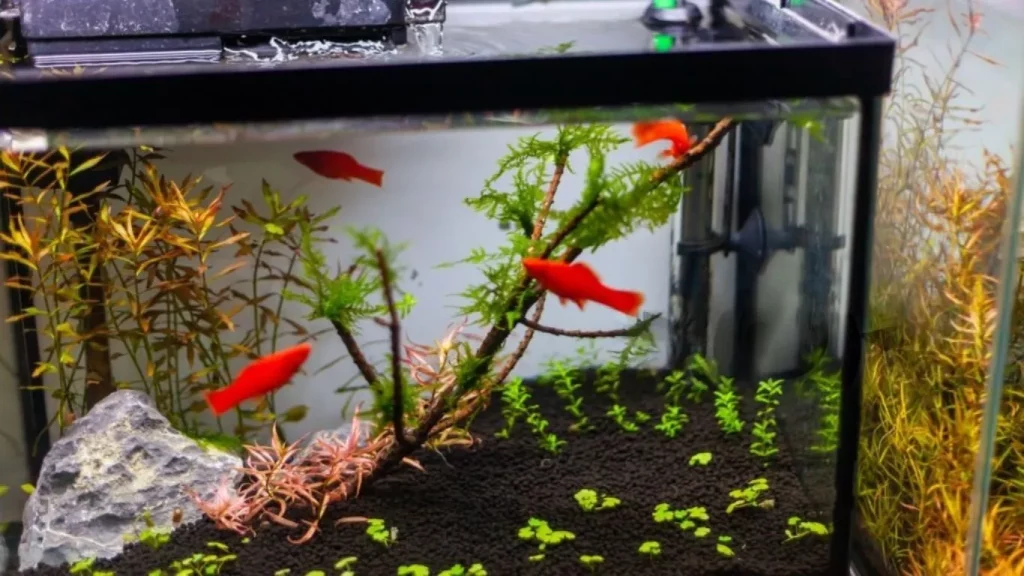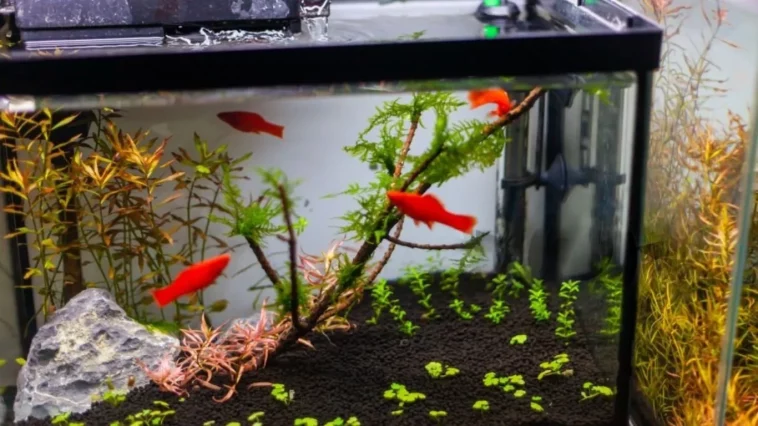Key Takeaways
- Tannins come from driftwood, leaves, or other organics and give aquarium water a brown or tea-colored tint.
- While not harmful to most fish, tannins can lower pH and affect water clarity.
- Water changes are the simplest way to dilute tannins over time.
- Activated carbon or Purigen in your filter quickly clears discoloration.
- Pre-soaking or boiling driftwood before adding it to the tank helps prevent future tannin buildup.
- Patience is key—tannins often fade gradually even with treatment.
To remove tannins from aquarium water, start with regular water changes and add activated carbon or Purigen to your filter to clear discoloration quickly. If the tannins are coming from driftwood, remove it and boil or soak it in clean water before returning it to the tank. While tannins aren’t harmful to most fish, they can lower pH, so managing them with filtration, water changes, and pre-treating new wood helps keep your aquarium clear and balanced.
Definition of Tannins in Aquarium Water
Tannins are natural organic compounds that can leach into aquarium water, influencing its color and properties. Derived from various sources, such as wood and leaves, tannins can have both aesthetic and functional impacts on aquariums.

Importance of Maintaining Water Quality in an Aquarium
Ensuring optimal water quality is a fundamental aspect of successful aquarium keeping. Water quality directly affects the health and well-being of aquatic life, making it essential for hobbyists to understand the factors influencing it.
Understanding Tannins
What are Tannins?
Tannins are a diverse group of compounds found in various plants, including wood and leaves. In aquariums, they are responsible for creating “brown water” or “blackwater” conditions.
Sources of Tannins in Aquarium Water
- Piece of Wood as a Common Source:
- Adding a piece of driftwood to the aquarium is a common practice among hobbyists. Driftwood slowly releases tannins into the water, affecting its color and chemistry.
- Driftwood and its Role:
- Driftwood, especially varieties like Malaysian driftwood or Mopani wood, releases tannins over an extended period, contributing to the overall aesthetic of the tank.
- Other Organic Matter and Indian Almond Leaves:
- Decomposing organic matter, such as dead leaves or Indian Almond Leaves, can also release tannins. These natural sources are often used intentionally to mimic the fish’s native habitat.
Assessing Water Quality
Importance of Monitoring Water Quality
Regularly monitoring water quality is crucial for maintaining a thriving aquarium ecosystem. This includes assessing tannin levels and other parameters that impact the overall health of fish and plants.
Measuring Tannin Levels in Aquarium Water
Measuring tannin levels involves observing the water’s color and using chemical tests to determine the concentration of tannins. Hobbyists often use water test kits to assess tannin levels accurately.
Maintaining Good Water Quality Practices
To ensure optimal water quality and manage tannin levels effectively, aquarium hobbyists should adopt certain practices.
Efficient Methods for Tannin Control
- Water Changes:
- Regular water changes, typically 1-2 times a week, help dilute tannins and maintain stable water parameters.
- Use of Carbon Filters:
- Activated carbon filters effectively absorb tannins, improving water clarity. Filter floss can also be used to mechanically remove particles.
- Choice of Wood:
- Selecting the right type of wood, such as Malaysian driftwood, and curing it properly can minimize excessive tannin release.
- Biological Methods:
- Implementing biological filtration, including sponge filters and bio filters, aids in breaking down organic matter and controlling tannin levels.
Natural Remedies and Additional Benefits
Shrimp Tanks and Anion Resin
- Shrimp Tank Benefits:
- Anion resin, known for its antimicrobial properties, benefits shrimp tanks by creating a healthier environment.
- Additional Food Source:
- Tannins from organic sources serve as an additional food source for aquatic organisms, supporting their nutritional needs.
- Charcoal Granules:
- Charcoal granules in the aquarium filter not only assist in removing tannins but also contribute to the overall medicinal effects within the tank.
FAQs About Removing Tannins from Aquarium Water
Tannins are organic compounds released by driftwood, leaves, or other decaying matter, causing water discoloration.
Excessive tannins can stain water, affecting the clarity and appearance of the aquarium. Some fish may also prefer clearer water.
If your aquarium water is tea-colored or brownish, it likely has elevated tannin levels.
In most cases, tannins are harmless, and some fish species even prefer slightly tinted water. However, plants may require clearer water for optimal growth.
Driftwood, leaves, and botanicals such as peat moss release tannins into the water.
Regular water changes, activated carbon, and the use of chemical absorbents like Purigen can help reduce tannin levels.
Opt for activated carbon specifically designed for aquarium use and replace it regularly to ensure effectiveness.
Yes, boiling driftwood or leaves can help release tannins faster, but it’s essential to monitor water quality during the process.
Yes, there are water conditioners and chemical absorbents available that target tannins and other organic compounds.
The time to clear water depends on factors like aquarium size, tannin concentration, and chosen removal methods. Regular testing helps monitor progress.
Yes, balance is key. You can maintain a natural appearance while managing tannins to ensure a healthy and visually appealing aquarium.
Follow the product instructions, but as a general guideline, replace activated carbon monthly and monitor chemical absorbents regularly for effectiveness.
Conclusion
Understanding tannins in aquarium water is crucial for maintaining a balanced and healthy aquatic environment. Hobbyists can embrace natural methods and efficient practices to manage tannin levels, ensuring both water quality and the well-being of their cherished aquatic inhabitants.







GIPHY App Key not set. Please check settings